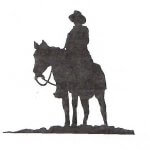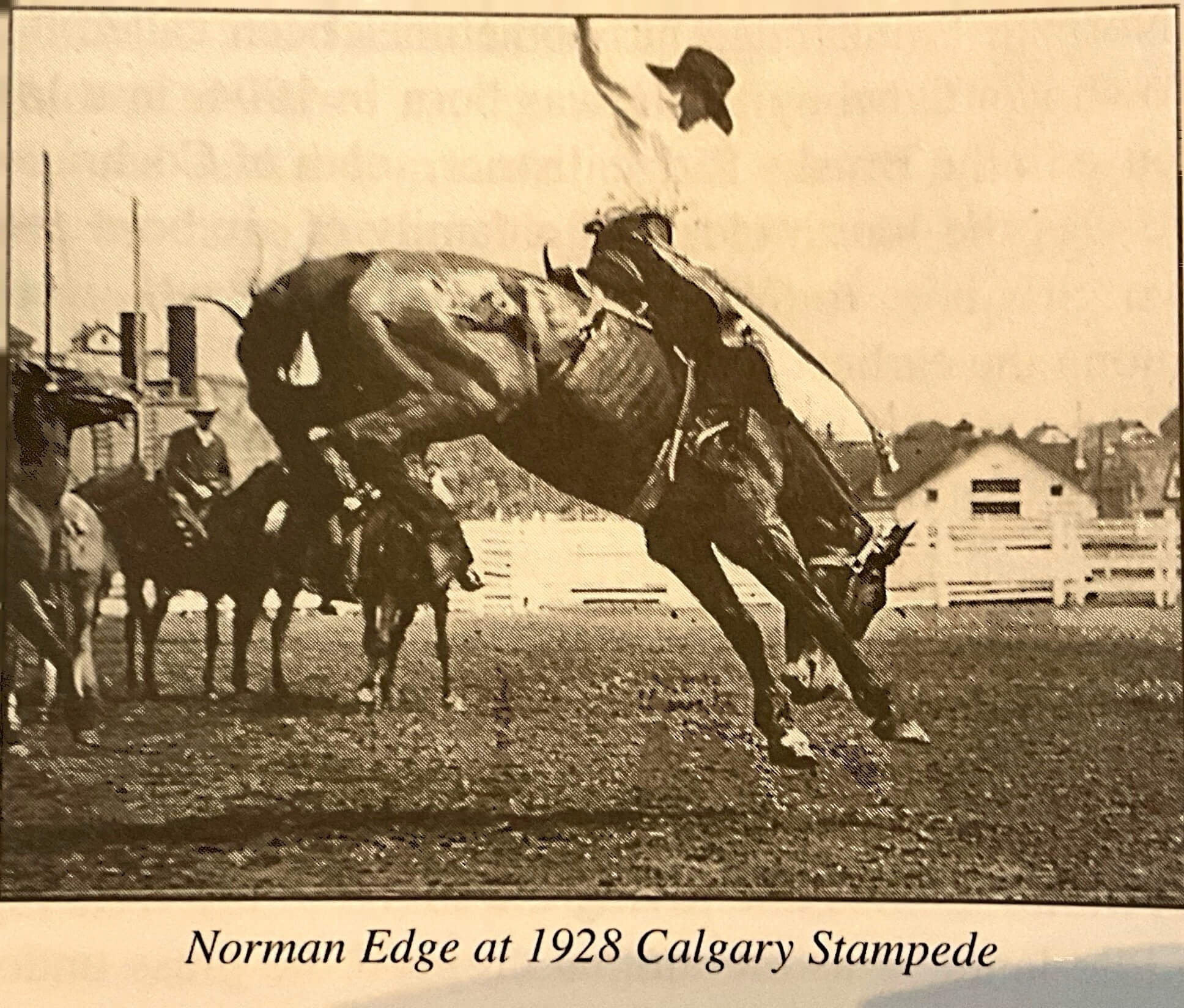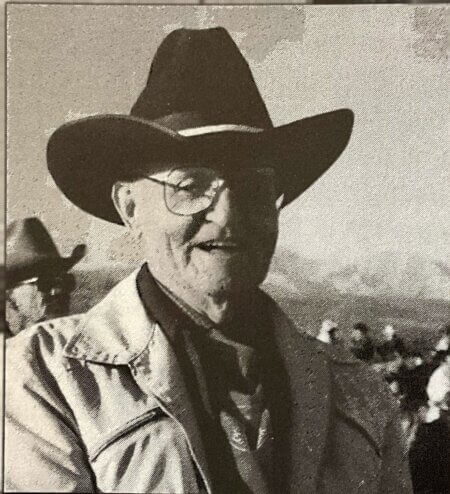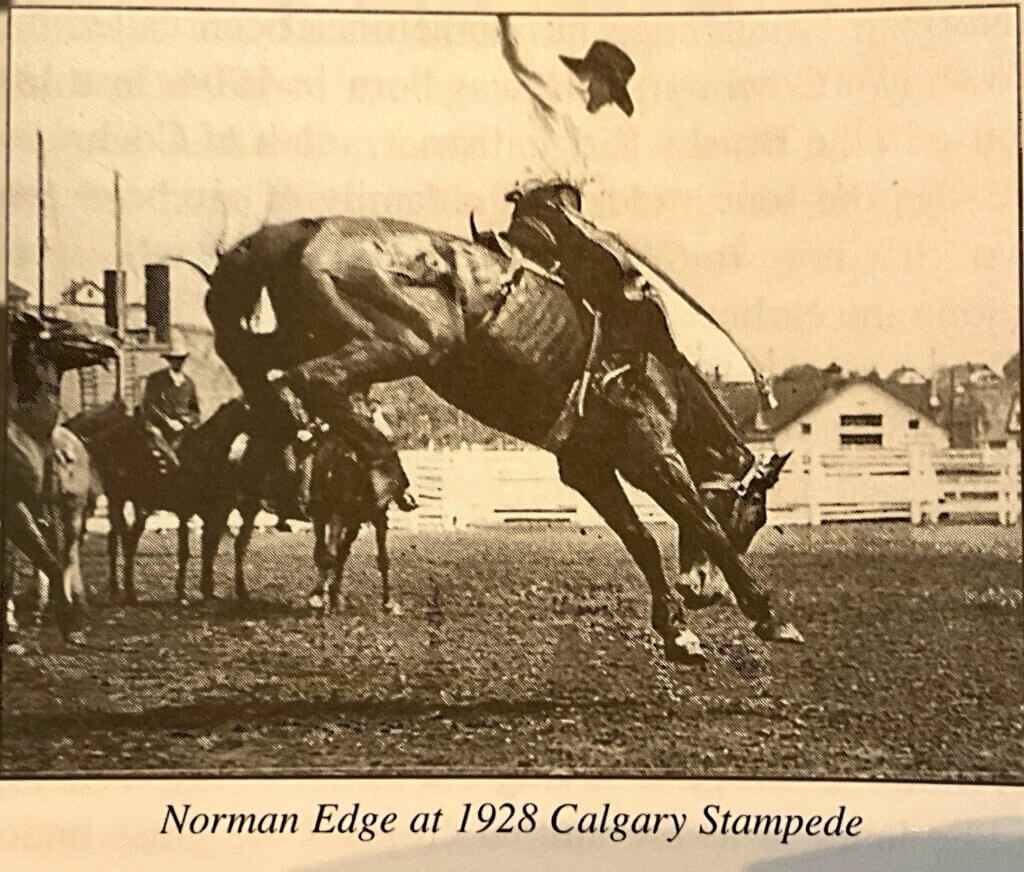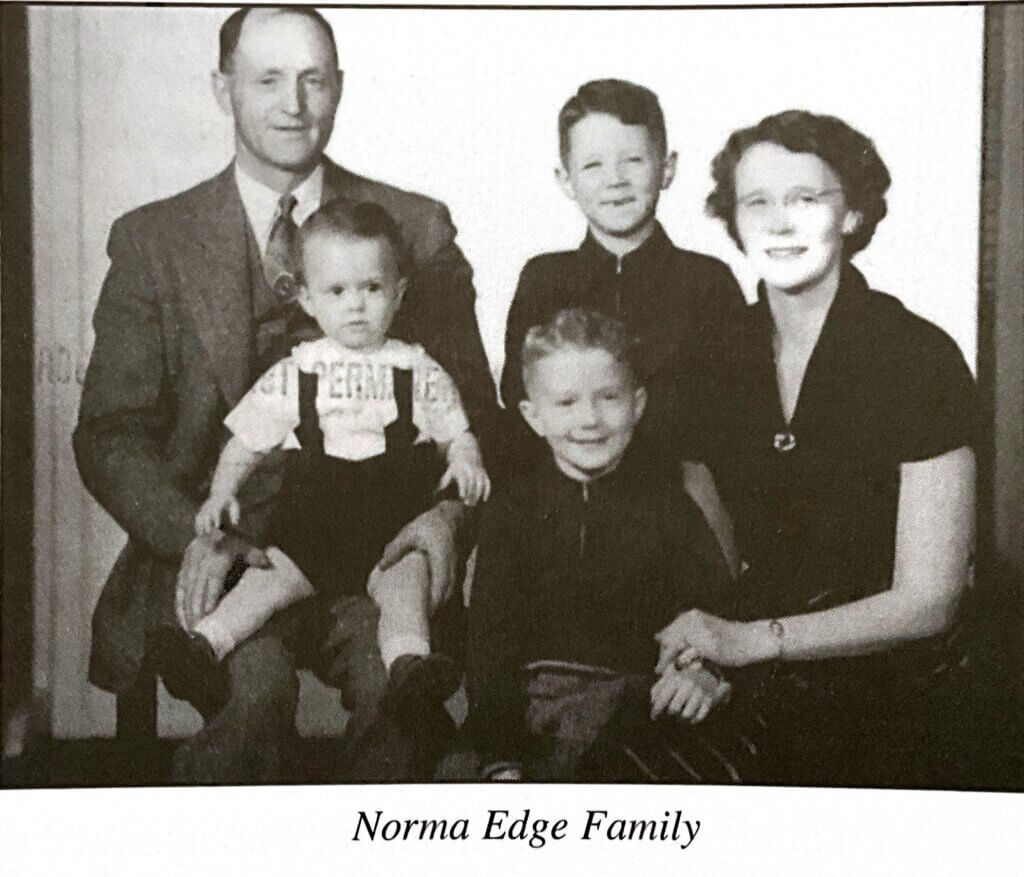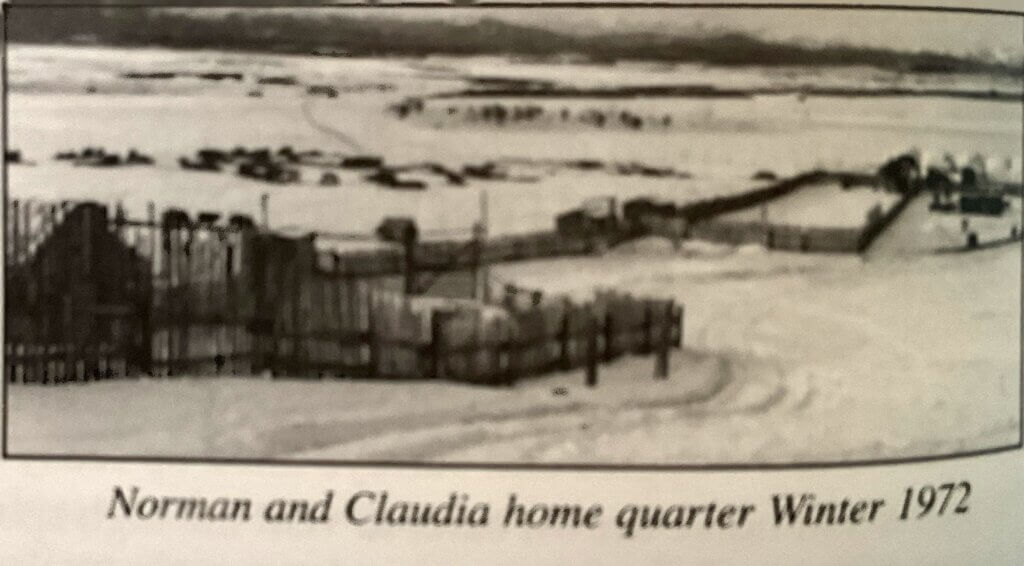page 423 More Big Hill Country 2009
Norman Frank Edge has sometimes been called “A Cowboy’s Cowboy”. He was born in 1904, in a log house in the Brushy Ridge district, south of Cochrane. He was the fourth eldest of a family of six boys and two girls born to William and Sarah Edge who were among the earliest settlers of this area.
When he was four or five years old, Norman and his brothers started rodeoing by riding pigs before they progressed to calves, and then to yearling steers or cows. He was born in a place and at a time when the horse was an essential part of living and his life had been strongly influenced by an interest in, and a love for, horses. He remembered, as a small boy, sitting on his father’s horse and loving the sound of the creaking saddle leathers as the animal cropped the grass under the heat of the noonday sun.
As teenagers, Norman and his brothers Ollie and Wilbert joined Sykes Robinson and other boys of the district to develop their rodeo skills on the neighbour’s steers, horses or even milk cows. The furious owners occasionally caught them snubbing-up an otherwise tame wheel horse.
In 1922, they started practicing on the XC Ranch, which was then owned by Dave Lawson. Dave encouraged the group to ride sale broncs, bareback and steers, as well as to rope. He built a chute which consisted of a hinged gate on each side of the horse with a small gate at his head. When the rider was ready, the gates were all flung back, called a shotgun chute.
The first rodeo Norman entered as a competitor was held in Sarcee about 1921. Norman and Wilbert hitched a ride on the mail truck with Jim and Bill Bateman. It was in the early twenties that Norman won the Novice Bronc Riding at Bragg Creek. There were rodeos held also at Morley, Jumping Pound, Cochrane and Bottrel.
The first Jumping Pound Rodeo was held in 1922. It was attended, among others, by Sykes Robinson, Peter Knight, Johnny Munro, Wilfred Sibbald, Eddie Bowlen, Horace Holloway, Percy Copithorne, Ollie Edge, Wilbert Edge and Norman Edge. Sykes won the Saddle Bronc event. Norman bucked off.
The lure of the “Big One” took them to Calgary in 1924 and many years thereafter. Since they had no money, they slept in the stock barns and ate pancakes instead of steaks. In 1925, Norman got lucky and won both the Brahma Steer Riding and Bareback Bronc Riding events. His name was engraved on both of the trophies but they had to be won twice to be kept. However, he did win a trophy saddle for being the win- ner of the Bareback Riding event.
In 1926, Norman and a bunch of cowboys went to Winnipeg to a rodeo sponsored by Peter Welsh, who was President of The Alberta Stampede Co. Ltd. Peter Welsh put on a string of rodeos in such places as Ottawa; Montreal; Toronto; Winnipeg; Vancouver:
New Westminster Columbus, Ohio; Detroit, Michigan; and Buffalo, New York. Welsh owned the most famous string of bucking horses including Midnight, Gravedigger, Tumbleweed, The Gold-Dust Twins, Five Minutes Midnight to and Bassano.Lad. While traveling to most of the Welsh rodeos, Norman missed the 1926 Calgary Stampede.
In 1927, Norman won the Brahma Steer Riding at Calgary and since this was his second time to win the sterling silver trophy, donated by P. Burns Co., he won permanent possession.
In 1928 he won the Bareback Bronc riding again and thus won outright the second sterling silver trophy, donated by Calgary Brewing and Malting Co.
Norman competed in the Wild Horse Race several years. Sometimes he worked with partners Bert Young and Lawrence Parge. In 1929, with partners Johnny Munro and brother Ollie Edge he won a pair of spurs for first place in this event.
In the years from 1923 to 1937, when he retired from active rodeo competition, Norman competed in rodeos at Jumping Pound, Calgary, Montreal, Columbus, Sundre, Hand Hills, Toronto, Pendleton, Vancouver, New Westminster, Hussar, Ottawa, Buffalo and White City Stadium in London, England.
In the early thirties he won three major events at the Hand Hills Stampede. These included the Saddle Bronc Riding, the Bareback Riding and the Brahma Steer Riding.
On May of 1934, a group of Canadian cowboys including Herman Linder, Jack Streeter, Pat Burton, Jackie Cooper, Clark Lund, Frank Sharp, George McIntosh, Harry Knight, Pete Knight and Norman Edge were chosen to travel to London to a rodeo spon- sored by Tex Austin. There were about twenty American cowboys who also went to this rodeo. Some of the Canadians had a contract to supply bucking stock, and to travel with the stock on the boat. To quote Norman, “It’s a damn good thing my contract included transportation home because I didn’t win a crying dime in England”. The English Humane Society was very strict. The cowboys were required to tape their spurs so that no rowel could be used. In the calf roping event, the first calf out ran into the fence and its nose started to bleed. That was the end of the roping. Fox Hastings, the cowgirl bulldogger, ran afoul of the law when it was decided that she was too rough on her dogging steers.
The cowboys traveled principally by train, seldom had money, ate sparingly but enjoyed life to the fullest. When one of the bunch won some money, they could all eat, but they certainly did not win their fortunes
often not even a grubstake. In periods between stampedes, Norman went home to hay, fence, put in the crop or harvest. Rodeo promoters of the day included Guy Weadick, Tex Austin, Peter Welsh and the Calgary Stampede.
On one trip to Eastern Canada, the train carrying the cowboys had just pulled into Montreal station where there were a few buggies and surreys lined up ready to take tourists in horse drawn carts to visit the high spots of the old city. A French driver was lying back in his rig sound asleep with his reins slack……….one of the bunch who had been in the “vinegar” and was well enough oiled to be looking for fun, saw the horse with its head hanging down, half asleep. He let out a war whoop and jumped astride the horse. The terrified animal plunged into a runaway gallop. The poor Frenchman went out over the back of his rig, landing on the cement. When the horse, with his rider, reached the streetcar tracks, he slipped and fell, break- ing the shafts as well as parts of the harness. When the horse got up he had suffered no injury but the French driver, now awake, came running, waving his arms, talking a mile a minute and calling for the police. In no time there were three or four streetcars held up and police coming from every direction. The cowboys were outnumbered about three to one and unable to understand a word of French. The cowboy who had started the whole fracas found himself with a police- man on each arm and two behind him, marching him off to the police station. In the meantime, some of the cowboys gathered up the pieces and set about getting the rig and harness fixed. The rest gathered around the French driver and persuaded him to go for a friendly drink. They thought that if they could get him feeling good, he wouldn’t lay a charge. Well, it sure worked! A few hours later, when they came out of the bar, they were the best of friends. He slapped the cowboys on the back and said, “You Wests is the best mens I meet”. When Mr. Welsh heard about the incident, he gave the boys a stern lecture. An incident such as that could hurt rodeo and cause a big drop in revenue. He fin- ished his talk by saying, “If they will just keep that cowboy in the jug overnight, I will know where at least one of you is in the morning.” On the front page of the next morning’s newspaper were these headlines: “MONTREAL BEING INVADED BY WESTERN WILDMEN HERE TO PERFORM IN RODEO”. This turned out to be the best advertisement the rodeo had and it was sold out by noon.
In 1925, Bill Bateman and Norman went to a Peter Welsh rodeo in New Westminster. At that rodeo they saw Peter Welsh’s famous jumping horse ‘Barra Lad’,
with sixteen year old Louis Welsh up, clear the bars at eight feet one and one half inches, a new World’s Record. After making the jump over a top bar that was, for all intents and purposes tied down, Barra Lad land- ed safely, but fell forward on his knees and shoulder because of the tremendous impetus of the jump. He was up again immediately and received a standing ova- tion and a horseman’s wreath of flowers. Before morn- ing he died from internal hemorrhaging, probably brought on by the terrific strain of the jump.
During the winters of 1925 and 1926, Norman broke polo ponies as well as remounts for the police at D.P. McDonald’s Mount Royal Ranch.
From the fall of 1929 to the fall of 1932, Norman broke polo ponies for T.B. Jenkinson, who operated the Virginia Ranch north of Cochrane, and then moved his stock to a ranch in the sand hills north of Medicine Hat. Norman recalled that one of the greatest privileges of his life was watching those thoroughbreds, tails and manes streaming, powerful muscles flexing, racing across the open prairie, sheer beauty in action.
By the time Norman retired from rodeo in 1937, he was already involved in a partnership with his brothers to run the ranch at Cochrane and at Bassano.
In 1940, in a ceremony which took place by the fire- place in the house which they had just built on NW Sec 35 Twp 24 Rge 4 W5, Norman married Claudia Lynn. Claudia is the daughter of Claude (Clyde) William Lynn and Ann Lynn. She is the second of six children and was born near Suffield, Alberta in 1914. She start- ed school at Black Diamond, but during her first year moved with her family to Calgary where she took the remainder of her education, except for some time at the University of Alberta in Edmonton.
In September of 1936, Claudia began teaching in the Little Jumping Pound School. After two years she moved to Springbank School and taught there until after she and Norman were married. From 1957 until 1974, when she retired, Claudia taught in the Cochrane Junior and Senior High Schools.
Norman and Claudia’s sons Garth, Barry and Lynn rode their horses to a one room country school. They won many trophies at local gymkhanas and later entered in Little Britches rodeos. Garth rode steers, Barry and Lynn roped calves. Garth followed the rodeo circuit seriously for two or three years and won a fair number of bull riding events, but eventually decided that rodeo was not for him. He farmed the land at Bassano for several years and then sold it to go into business. Lynn roped in Little Britches, but found that University and rodeo do not make enough time for either. Barry has been able to rope for many years.
Garth and Barb Edge live in Columbia Falls, Montana. Garth’s son Marshall (from a previous mar- riage) lives in London, Ontario. Marshall and his wife Kristine have three daughters: Mackenzie, Julia and Jacklyn. Marshall is an engineer and works for a com- pany called Sonometics that specializes in computer- ized heart technology.
Barry and Linda Edge ranch at Rimbey, Alberta and have two sons, Timothy and Dean. Timothy works for Euro-Disney in Paris, France and runs the Wild West Show. As a cowboy and an actor, he is “Wild Bill Hickok” in the show as well as a trick roper and stage- coach driver. Dean and his wife Jeanine live in Rimbey. Dean won the Canadian Auctioneering Championship and has placed third in the world. He has also been to the Canadian Finals Rodeo three times as a tie down calf roper. Jeanine works as a cosmetic con- sultant for Arbonne and part time at the auction mart.
Lynn and Judy Edge live in Cochrane. Lynn worked in the oil and gas patch for many years and was in charge of the commodity trading floors for some prominent companies. Lynn retired from the oil and gas industry and now works on the family ranch with his cutting horses. Judy is principal of a school in Calgary. Judy’s daughter, Robyn and her husband Dean Bilsky live in Edmonton with their two sons Colton and Kaden. Robyn is a teacher and Dean is a heavy duty mechanic. Lynn and Judy’s daughter, Roz lives on the home quarter with her husband Gary Kossowan and their son Korbin. Gary is a framer and Roz is a Pharmacy Technician.
Norman and Claudia thoroughly enjoyed their years as members of the Cochrane Light Horse Association. Besides competing in gymkhanas, they worked at such enterprises as building floats to represent Cochrane in the Calgary Stampede Parade.
In the spring of 1949, Norman got back to rodeo as a chute judge and chuckwagon judge at the Calgary stampede. He worked with old friends such as Frank Sharp, Percy Bennett, Don Thompson, Allie Streeter, Joe Fisher, Clark Lund, Dick West, Bob Carry, Eric Hodgson, Jiggs Boyce, Clarence Gingrich, Warren Cooper and many others. Norman worked at the Stampede up to and including 1955.
During the 1974 Stampede Norman, together with Eddie Watrin and Peter Vandermere, were honoured as old time cowboys. Each was presented with a framed poster and silver cufflinks. The inscription below the poster reads: “Norman Edge; In Appreciation For Your contribution To Rodeo; Calgary Exhibition and Stampede 1974”. In 1975, Norman received the same honour from Red Deer. The inscription on the plaque reads; “To Norman Edge For His Outstanding Contribution To the World of Rodeo Over A Period Of Many Years; Red Deer Exhibition Association, 1975”. At the Old timers’ Rodeo in Cochrane in 1983, Norman, together with Frank Sharp, Warren Cooper and Lloyd Dolen, received a plaque which is engraved; “Thanks Norman Edge. In appreciation For Your Dedication To The Sport Of Rodeo”.
Rodeo was a basic part of Norman’s life. There is a mystic call that speaks of our pioneer roots that certain- ly does not appeal to everyone. However, those who hear that call are willing to tackle a life of little mone- tary reward for the sense of accomplishment, in a sport which is strictly an individual effort.
